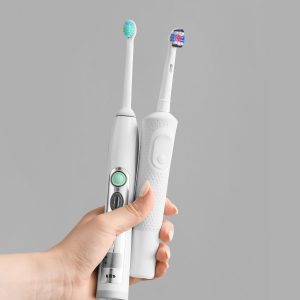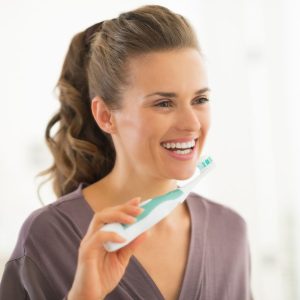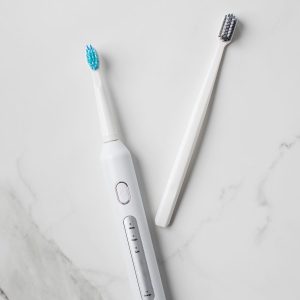Electric Toothbrush vs Manual – Which Is Better?
Brushing your teeth is one of the simplest but most important steps for protecting your oral health. But many patients ask: “When it comes to an electric toothbrush vs manual, which is better?” Both can clean your teeth effectively, but the right choice depends on your technique, preferences, and dental needs.
At Gentle Dental Centre in Wanneroo, we guide patients every day on finding the toothbrush that works best for them. Here’s what the research – and our experience – says.
Do Dentists Actually Recommend Electric Toothbrushes?

Yes, dentists often recommend electric toothbrushes, especially for patients who struggle with technique or have gum disease. According to the Cochrane Oral Health Group (2014), electric toothbrushes – particularly oscillating-rotating models like Oral-B – reduced plaque and gingivitis more effectively than manual toothbrushes, both short and long term.
Australian dentists agree. Orthodontics Australia highlights that electric brushes are especially helpful for people with limited dexterity, while National Dental Care notes that oscillating brushes with small heads usually outperform manual brushes in plaque removal.
That said, the Australian Dental Association points out that with correct technique, manual toothbrushes can still be effective.
Electric Toothbrush vs Manual - Side By Side Comparison
| Feature | Electric Toothbrush | Manual Toothbrush |
|---|---|---|
| Plaque Removal | Studies show oscillating brushes reduce more plaque and gingivitis over time. | Effective if technique is perfect, but most people don’t reach 100% efficacy. |
| Ease of Use | Does the work for you, built-in timers and pressure sensors help. | Requires correct technique and consistent effort. |
| Gum Health | Gentler for receding gums (with pressure sensors) and arthritis patients. | Risk of scrubbing too hard – gum recession. |
| Cost | Entry models ~$50, higher models $150+. Replacement heads needed. | $3–$8 per brush. Replace every 3 months. |
| Suitability | Best for children, elderly, braces, gum disease, or limited dexterity. | Fine for low-risk patients with excellent technique. |
| Portability | Needs charging, bulkier to travel with. | Lightweight, no batteries needed. |
Both options can work, but most patients achieve better results with electric toothbrushes – especially when comparing electric toothbrush vs manual over the long term.
What Are the Disadvantages of an Electric Brush?
While electric toothbrushes have many benefits, they aren’t the perfect solution for everyone.
The biggest drawback for many patients is the cost. Electric toothbrushes are significantly more expensive upfront compared to manual brushes, and the ongoing cost of replacement heads (which need changing every 3 months) adds up over time. They also require charging or batteries, which can be inconvenient if you travel often or forget to recharge.

Some patients also find the vibrations and noise overstimulating, particularly those with sensory sensitivities. For example, people with autism, ADHD, or sensory processing challenges may feel uncomfortable using a vibrating brush, even though it’s highly effective. Others simply dislike the buzzing sensation in their mouth or find it ticklish on sensitive gums.
In rare cases, patients can still overbrush with an electric toothbrush – pressing too firmly, even with the help of pressure sensors. While electric models make this less likely than with manual brushing, it’s still important to learn the right technique and not rely solely on the technology.
Despite these disadvantages, most patients find that the benefits outweigh the drawbacks, especially if they are at higher risk of gum disease, tooth decay, or struggle with brushing technique.
What Are the Disadvantages of Manual Brushes?
While manual toothbrushes are inexpensive and easy to replace, they rely heavily on the user’s brushing technique. For many patients, this is where the disadvantages start to show.

One of the biggest risks is brushing teeth and gums bleed due to aggressive scrubbing. Without built-in pressure control, it’s easy to press too hard, which can cause gum irritation, gum recession, and even wear away enamel over time. This can sometimes be linked to personal habits – for example, patients with high anxiety or conditions like OCD may brush excessively or too forcefully without realising they’re damaging their enamel and gums.
Manual brushes also make it harder to maintain consistency. Most people brush for less than the recommended two minutes and miss hard-to-reach areas, leaving behind plaque that can cause cavities and gum disease. Unlike electric toothbrushes, manual brushes don’t come with features such as timers, oscillating or vibrating bristles, or pressure sensors. This means there’s no support to help you avoid common mistakes like brushing too fast, pressing too firmly, or skipping the back teeth.
For patients with braces, arthritis, or limited dexterity, manual toothbrushes can be particularly challenging to use effectively. That said, manual toothbrushes can still be effective for patients with excellent technique, strong daily habits, and low risk of gum disease or decay. The problem is that most people don’t meet those standards consistently, which is why dentists often recommend upgrading to an electric model.
Is It Normal For Gums To Bleed When Using An Electric Toothbrush?

No – healthy gums shouldn’t bleed whether you use a manual or an electric toothbrush. If your gums bleed regularly, it’s usually a sign of gum inflammation such as gingivitis, or even early gum disease, rather than the toothbrush itself. An electric toothbrush often makes bleeding more noticeable because it removes plaque more effectively and stimulates the gums, revealing underlying inflammation that might not have been as obvious with a manual brush.
Some patients also notice their gums bleed when flossing or when brushing teeth and gums bleed after switching to an electric brush. This doesn’t mean the toothbrush is harmful – it means your gums need extra care and professional cleaning to restore health. Ignoring the bleeding can allow gum disease to progress, leading to further problems like gum recession, tooth sensitivity, or bad breath.
The good news is that bleeding gums can often be reversed with the right care.
A professional dental hygiene appointment will remove the plaque and tartar build-up that causes irritation, while regular check-ups ensure problems are caught early.
If you’re experiencing bleeding gums, we can help identify the cause and provide tailored advice and treatment options during your appointment. Book a visit with our friendly team today.
Are Electric Toothbrushes Better For Receding Gums?

Yes – electric toothbrushes can be especially helpful for patients with gum recession. One of the main causes of recession is overbrushing with a manual toothbrush, where too much force gradually wears away the gumline. Many modern electric brushes include pressure sensors that alert you if you’re pressing too hard, helping to protect delicate gum tissue.
Sonic models, such as Philips Sonicare, also use a gentler vibrating motion that cleans effectively without the need for scrubbing, making them a good option for patients with sensitivity or exposed roots. While gum recession itself cannot be reversed without surgical treatment, using the right toothbrush can slow progression, reduce sensitivity, and protect your remaining gum tissue.
If you’re concerned about gum recession, your dentist can recommend the best brushing technique and toothbrush type for your needs. You may also find our resources on bleeding gums and dentist sensitive teeth helpful for understanding related concerns.
What’s the Point of a Vibrating Toothbrush?
Sonic toothbrushes (like Philips Sonicare) vibrate at up to 30,000-40,000 strokes per minute. This high-frequency action agitates fluid and toothpaste between the teeth, allowing cleaning beyond where the bristles physically touch. It’s especially useful for patients with braces or tight spaces where plaque builds up.
Cost Comparison - Electric Toothbrush vs Manual

When comparing an electric toothbrush vs manual, cost is often one of the first considerations.
- Manual Toothbrushes: These are the most affordable option, generally priced between $3 and $8. They should be replaced every 3 months or sooner if the bristles fray. Over the course of a year, this adds up to about $12-$30, making them a budget-friendly choice.
- Electric Toothbrushes: Electric models have a higher upfront cost. Entry-level Oral-B models start around $50, while premium options like the Oral-B Triumph 5000 can exceed $200. Sonic toothbrushes, such as Philips Sonicare, are also popular, typically ranging from $150-$300 depending on the model. Replacement brush heads are an additional cost, usually $20-$40 for a pack of two to four, and like manual brushes, should be replaced every 3 months. Over a year, this can add another $40-$80 to your brushing budget.
While the numbers may seem high, many patients find the long-term benefits outweigh the cost. Studies suggest that electric toothbrushes remove plaque more effectively and reduce gum inflammation, which may mean fewer fillings, less risk of gum disease, and ultimately lower dental bills in the future. For patients with braces, arthritis, or higher risk of tooth decay, the extra investment can be particularly worthwhile.
At Gentle Dental Centre, we offer Oral-B toothbrushes at both entry-level and deluxe models, and you can even try our Oral-B Test Drive in the clinic before committing to a purchase. That way, you can see whether the investment is right for you.
How To Choose The Right Toothbrush For You

Choosing between an electric toothbrush vs manual isn’t always about which one is “better” overall – it’s about which is best for you.
- Manual Toothbrushes: These are a great choice for patients who already have excellent brushing technique and low risk of gum disease or tooth decay. If you’re diligent about brushing for the full two minutes, twice daily, and flossing regularly, a manual toothbrush can keep your teeth and gums healthy. They’re also convenient for travel, inexpensive, and easy to replace.
- Electric Toothbrushes: These are often the better option for patients who need extra support in their routine. Children, elderly patients, people with braces, and anyone with limited dexterity (such as arthritis) often find electric toothbrushes easier to use effectively. Electric brushes also provide built-in timers, pressure sensors, and more consistent plaque removal, making them particularly helpful for patients with a history of gum disease, cavities, or difficulty sticking to a proper technique.
It’s also worth considering lifestyle factors. If you’re someone who often rushes through brushing or struggles to reach awkward areas at the back of the mouth, an electric toothbrush can make the process much easier. On the other hand, if you travel frequently or don’t want to worry about charging and replacement heads, a manual toothbrush may suit you better.
Ultimately, the most important factor is consistency. The best toothbrush is the one you’ll actually use – twice a day, for two minutes, with the right technique. For personalised advice, your dentist or hygienist can help assess your brushing habits and recommend the brush that will work best for your needs.
Try It At Gentle Dental Centre

Still unsure whether to choose an electric toothbrush vs manual? At Gentle Dental Centre in Wanneroo, you can try the Oral-B Test Drive during your appointment using your own brush head. We’ll also show you how both Oral-B and Philips Sonicare models work, so you can make an informed choice.
If you’re looking for a trusted dentist in Wanneroo, our friendly team at Gentle Dental Centre Wanneroo is here to help with everything from teeth cleaning appointments to gum care and personalised oral health advice.

